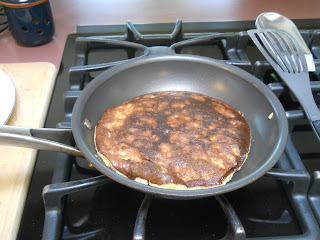Definitely people have their qualms about it, and definitely some people sign up and then don't give a gift, but in general, I think the system is pretty awesome. The first time I participated, I received Killer Bunnies drinking glasses from someone who does glass etching as a hobby. A more recent time, I sent someone some awesome stationary and was rewarded with pictures of their cat playing in the box.
This time around, my especially generous gifter gave me a cast iron pizza pan, which is incredibly useful for things like making pizza. And bread. Oooooh joy the bread baking I will be doing.
And seriously, look at that beautiful pizza. Doesn't it make you just want to immediately pop that baby in the oven and replicate that beautiful pizza?
Not so fast. First you have to make the dough, and that takes time. You have to mix up some yeast and some water and some other things and let them sit so the yeasty babies can get ready to start nomming on some gluten. Or however that works.
Then you have to add enough flour to make the dough easy to handle so when you knead it, it doesn't stick to your hands.
Note: two easy indicators of "easy to handle". The shinyness of it (this dough is shiny and therefore damp enough to be sticky). Also, the amount it sticks to your stirrer. You can see here that it was still sticking to my stirrer a lot.
Once my dough was "easy to handle" (note: mine wasn't, quite), I spread some flour over the counter to prepare for kneading. I usually recommend putting a cookie sheet down or something to contain the flour, for easier cleanup, but... I felt like making a mess this time around.
Plop that baby down and knead it!
Probably my favorite part of the baking process, it's hard to do wrong and it's so meditative.
Eventually the gluten gets super strong and your dough becomes... bread-dough like. Nice and smooth and, in this case, a little too sticky and shiny.
But that's okay, I just left it out to rise, and then put it in the fridge.
Two days later, it was time to make pizza.
I sprayed the pan with cooking spray, since this is new cast iron and not quite non-stick yet. Spread out the dough, added my favorite toppings (cheese and sauce) and my dad's favorite topping (anchovies).
Then it went in the oven.
As an out of order aside - this is a "pizza docker". I got it in a previous redditgifts exchange, and hadn't used it yet. You roll it over your pizza dough after spreading it out over the pan but before adding toppings to poke out any air bubbles in the dough. I think. I'm not 100% sure yet, but I did it, and the pizza turned out nicely, so I guess it did its job.
See? Pizza! It was a little bit doughy on the top of the crust in the center, but still delicious. Our ideas for improvement of the slight doughyness:
1) Less watery sauce
2) Cook the crust for ~5 minutes before adding toppings
3) A little more flour in the dough (as I mentioned, it was still a bit sticky)
4) Pre-heating the pan and sliding the pizza onto it like they do in fancy pizza shops with stone ovens.
Overall? Would definitely make again. Actually, I have been informed that I will be making it again in 2 days. Hopefully it goes as well or better this time.
Pizza
Recipe from my dear friend Kathrine
Makes one 12 inch pizza (I doubled the recipe to make a 14 inch pizza with a thick crust, and it was perfect)
Ingredients:
1/2 cup water (around room temperature)
2 and 1/4 teaspoons or one package of yeast
1 and 1/2 cups all-purpose flour
1 teaspoon olive oil
1/2 teaspoon sugar
Some salt (between 1/4 to 1 teaspoon)
Cooking spray
Toppings of choice
- In a large bowl, dissolve the yeast in the warm water. With a spoon, stir in half of the flour and all of the oil, salt and sugar. Stir in enough of the remaining flour, 1/4 cup at a time, until the dough is easy to handle.
- Sprinkle flour lightly on a countertop or large cutting board. Place the dough on floured surface. Knead by folding the dough toward you, then with the heels of your hands, pushing the dough away from you with a short rocking motion. Move the dough a quarter turn and repeat. Continue kneading about 10 minutes, sprinkling surface with more flour if the dough starts to stick, until the dough is smooth and springy.
- Spray a large bowl with the cooking spray. Place the dough in bowl, turning it to grease all sides. Cover the bowl loosely with plastic wrap, and let it rise in a warm place 20 minutes.
- Gently push your fist into the dough to deflate it. Cover the bowl loosely with plastic wrap; refrigerate at least 2 hours but no longer than 48 hours. (If dough should double in size during refrigeration, gently push your fist into the dough to deflate it.)
- Heat the oven to 425°F.
- Spread out the dough on a pizza pan or pizza stone, sauce and cheese and top your pizza how you want it, and then cook for 15-20 minutes.

































